【新课标】Module 1 Wonders of the worl Unit 3 Language in use. 课件
文档属性
| 名称 | 【新课标】Module 1 Wonders of the worl Unit 3 Language in use. 课件 | 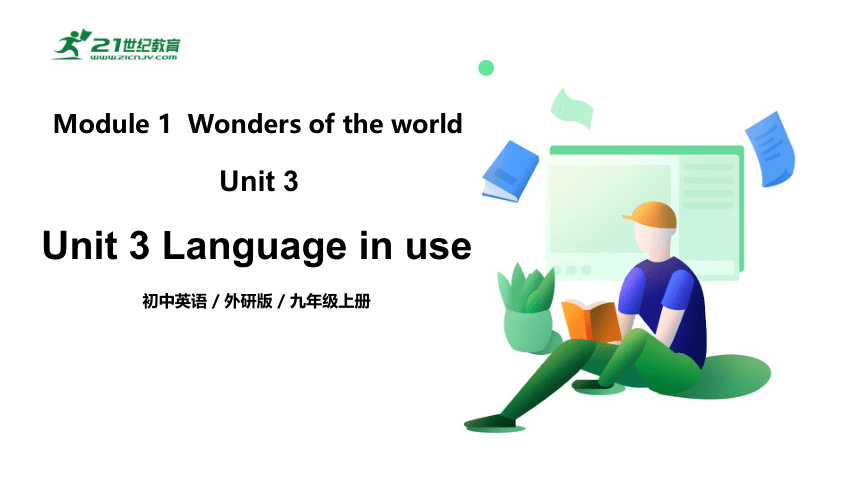 | |
| 格式 | pptx | ||
| 文件大小 | 2.8MB | ||
| 资源类型 | 试卷 | ||
| 版本资源 | 外研版 | ||
| 科目 | 英语 | ||
| 更新时间 | 2022-07-04 10:21:03 | ||
图片预览

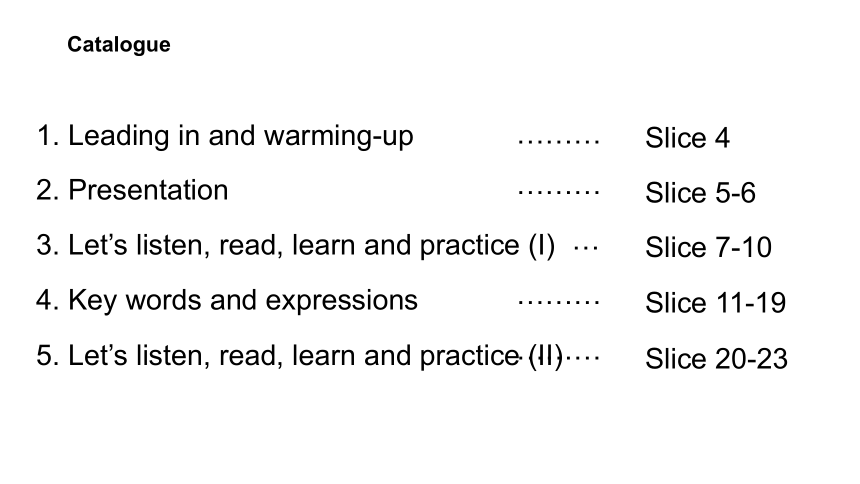
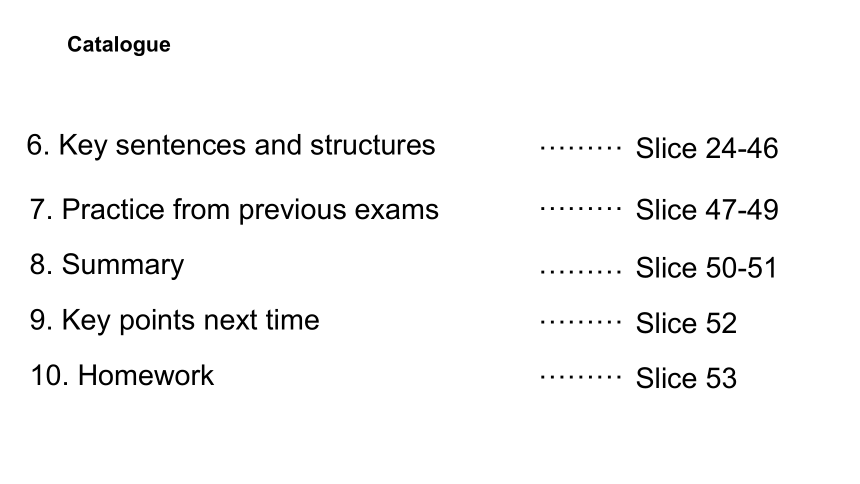
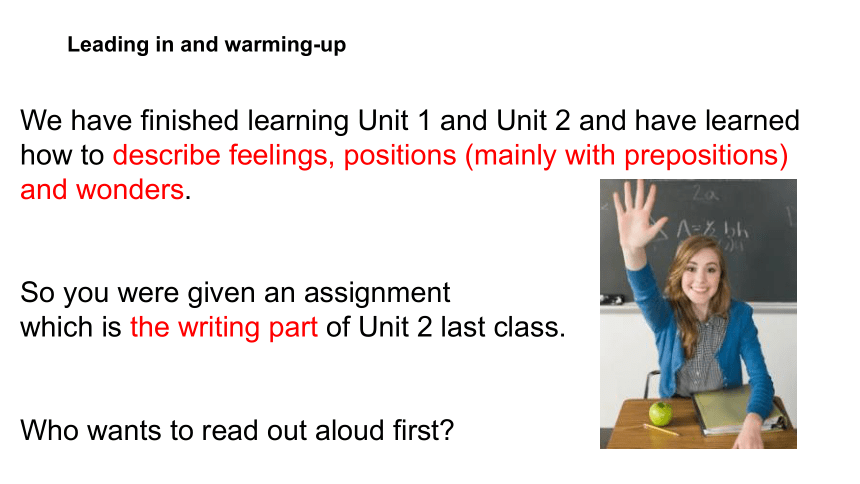
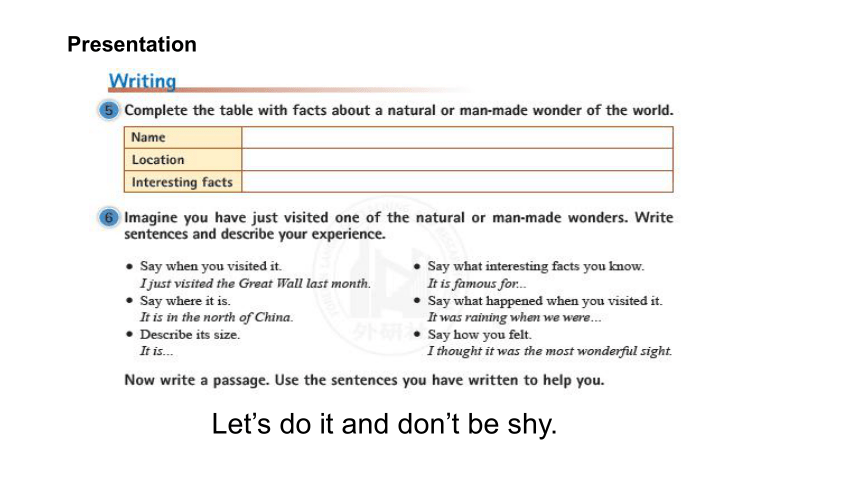
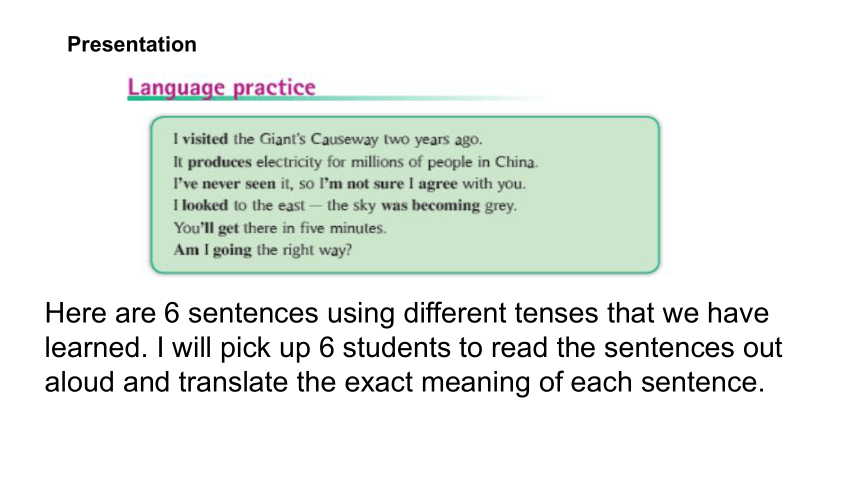
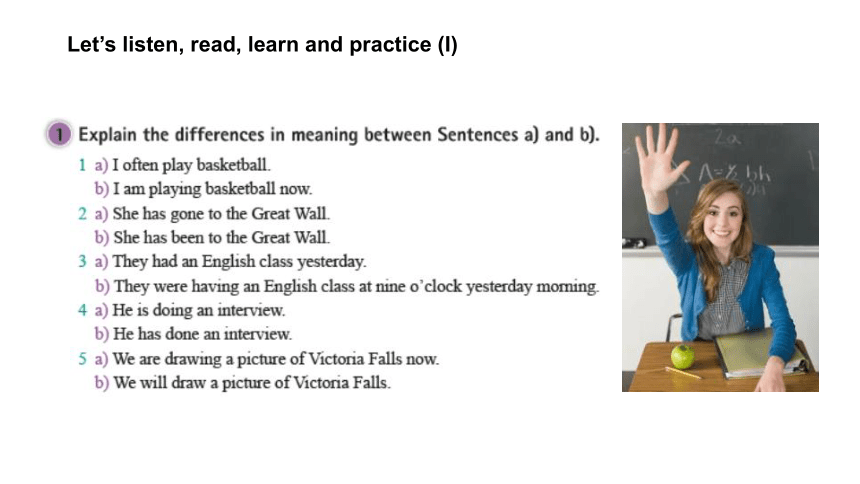
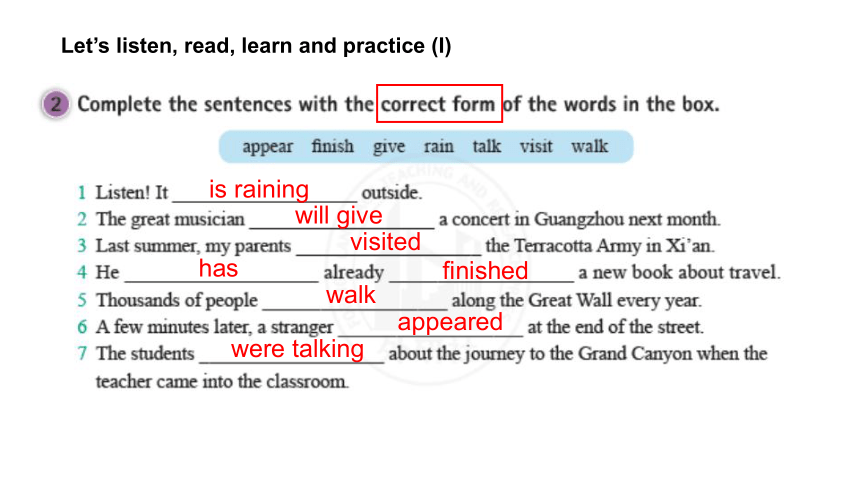
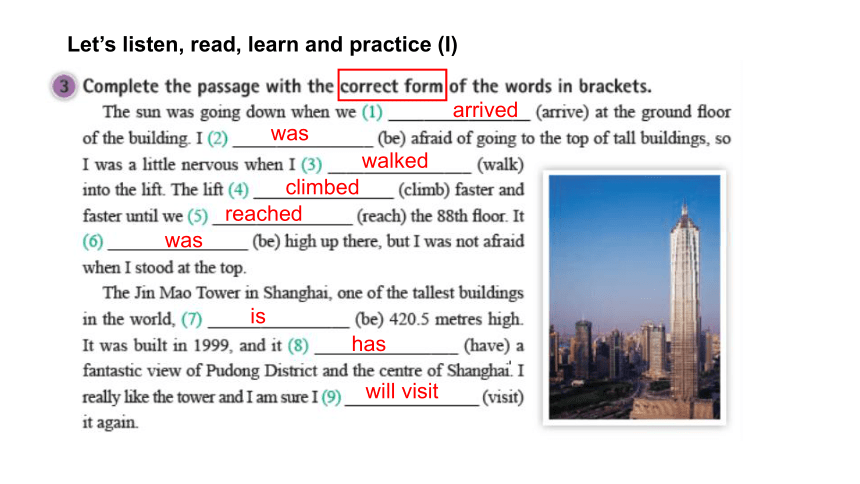
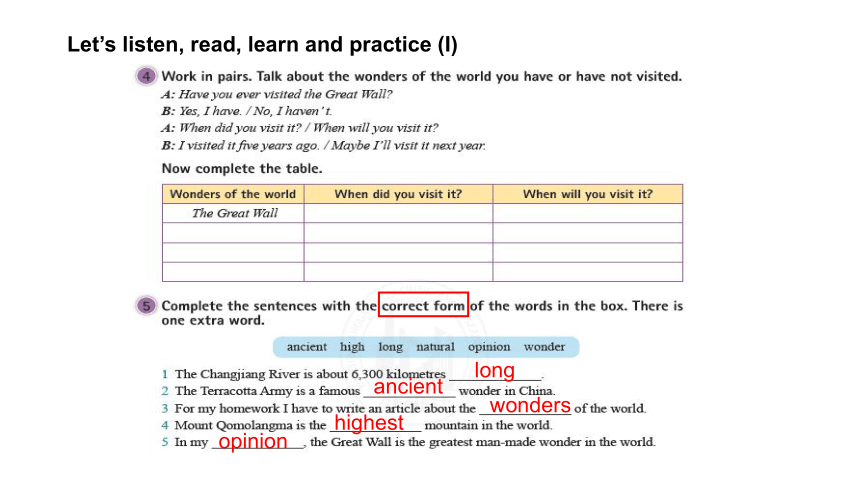
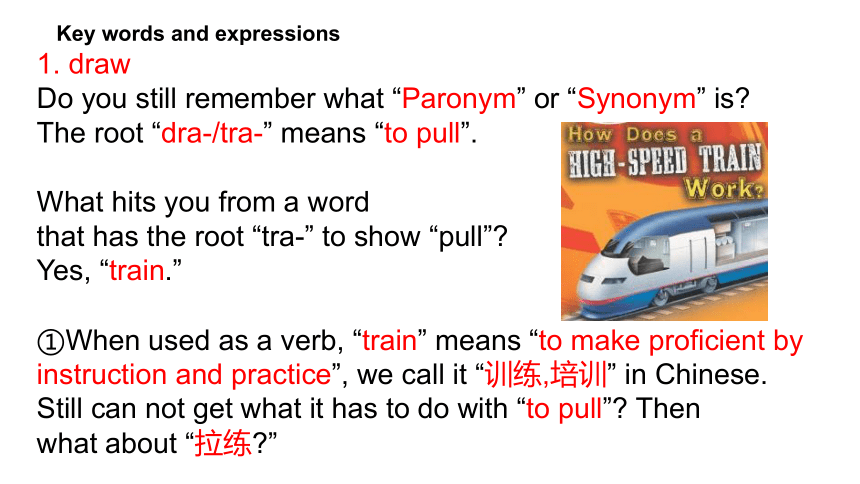
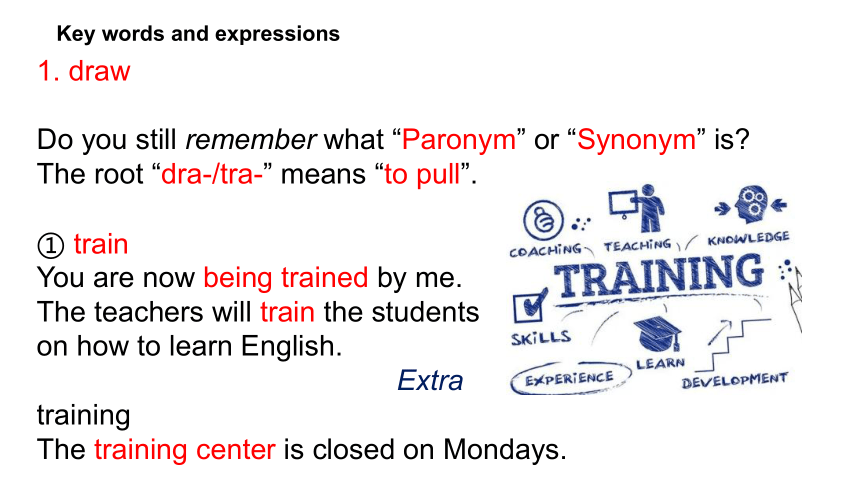
文档简介
(共55张PPT)
Unit 3 Language in use
初中英语 / 外研版 / 九年级上册
Module 1 Wonders of the world
Unit 3
Catalogue
1. Leading in and warming-up
2. Presentation
3. Let’s listen, read, learn and practice (I)
4. Key words and expressions
5. Let’s listen, read, learn and practice (II)
Slice 4
Slice 5-6
Slice 7-10
Slice 11-19
Slice 20-23
………
………
………
………
…
Catalogue
7. Practice from previous exams
8. Summary
9. Key points next time
10. Homework
Slice 52
Slice 47-49
Slice 50-51
Slice 53
………
………
………
………
6. Key sentences and structures
Slice 24-46
………
Leading in and warming-up
We have finished learning Unit 1 and Unit 2 and have learned how to describe feelings, positions (mainly with prepositions) and wonders.
So you were given an assignment
which is the writing part of Unit 2 last class.
Who wants to read out aloud first
Presentation
Let’s do it and don’t be shy.
Presentation
Here are 6 sentences using different tenses that we have learned. I will pick up 6 students to read the sentences out aloud and translate the exact meaning of each sentence.
Let’s listen, read, learn and practice (I)
Let’s listen, read, learn and practice (I)
is raining
will give
visited
finished
has
walk
appeared
were talking
Let’s listen, read, learn and practice (I)
will visit
arrived
was
walked
climbed
reached
was
is
has
Let’s listen, read, learn and practice (I)
long
ancient
wonders
highest
opinion
Key words and expressions
1. draw
Do you still remember what “Paronym” or “Synonym” is
The root “dra-/tra-” means “to pull”.
What hits you from a word
that has the root “tra-” to show “pull”
Yes, “train.”
①When used as a verb, “train” means “to make proficient by instruction and practice”, we call it “训练,培训” in Chinese.
Still can not get what it has to do with “to pull” Then
what about “拉练 ”
Key words and expressions
1. draw
Do you still remember what “Paronym” or “Synonym” is
The root “dra-/tra-” means “to pull”.
① train
You are now being trained by me.
The teachers will train the students
on how to learn English.
Extra
training
The training center is closed on Mondays.
Key words and expressions
1. draw
Do you still remember what “Paronym” or “Synonym” is
The root “dra-/tra-” means “to pull”.
② dragon (controversial)
drag+on:
When “on” follows a verb,
it normally shows the verb,
or the action, will continue
for a while, such as:
Speak on.
Write on.
Go on.
Key words and expressions
1. draw
Do you still remember what “Paronym” or “Synonym” is
The root “dra-/tra-” means “to pull”.
② dragon (controversial)
So what does “drag+on” have
anything to do with “龙”
or “continue dragging”
The picture on the right tells us
Key words and expressions
1. draw
Do you still remember what “Paronym” or “Synonym” is
The root “dra-/tra-” means “to pull”.
③ draw
We had to draw the broken car
out of the road.
Mary drew a house on the paper.
I'll draw some money from my account.
Extra
drawer: He found the money secreted in a drawer.
Key words and expressions
2. lift
①When used as a verb, “lift” means “to raise sth”, sometimes even “to cancel sth.”
He was too weak to lift his hands.
The good news lifted my spirits.
They decided to lift the ban on the player.
② n. ≈ elevator
He pressed the button to call the lift.
Let’s go down by the elevator.
Key words and expressions
3. poster and post
①”post” has so many meanings that we must know. Let’s get them in sentences.
He has no chances for the post.
Your duties are sending and receiving posts.
I shared your post in the friend circle.
I would be quite grateful if you would post this letter.
Will you please keep us posted for this accident
The news has been posted up everywhere in the city.
② Now you know how the word “poster” comes from “post”
Key words and expressions
4. interview
”inter-” means “mutual” or “each other” and “view” means “to look at or see sth”.
When you put “inter-” and “view” together,
it means “to look at each other”,
so it means “面试, 采访”.
I have an interview tomorrow.
Everyone will be interviewed before getting the job.
It is a pre-match/post-match interview.
Key words and expressions
4. interview
Extra
We use “-er” to show “active” while “-ee” to show “passive”
Try to compare the following words:
interviewer vs interviewee
inviter vs invitee
payer vs payee
Right now I think you will understand how the words “internet”, “international”, “interact”, and “intercity” come and what
they mean.
Let’s listen, read, learn and practice (II)
looking forward to
millions of
go through
more than
at the bottom of
agree with
Let’s listen, read, learn and practice (II)
Let’s listen, read, learn and practice (II)
Let’s listen, read, learn and practice (II)
Key sentences and structures
1. The important tenses we’ve learned and the key differences
①The Simple Present Tense
When something happens regularly or is a permanent situation, we usually use the simple present tense.
When using the simple present, the verb (with the exception of the auxiliary verbs) remains in the dictionary form (verb + s with he/she/it).
What do you do I'm a teacher.
What does he do He's a teacher.
Where do you live I live in Beijing.
Where does he live He lives in Beijing.
Key sentences and structures
1. The important tenses we’ve learned and the key differences
①The Simple Present Tense
The simple present tense is also used to show how often something happens with adverbs of frequency - always, usually, often, sometimes, occasionally, seldom, rarely, never, etc.... And when discussing daily, weekly, monthly etc. routines.
Amy always gets up at 6.00.
I never drink coffee before 12.00.
Key sentences and structures
1. The important tenses we’ve learned and the key differences
①The Simple Present Tense
The simple present tense can also be used to discuss future events, or to ask for and give instructions or to discuss a series of actions.
First turn left at the first crossing, and walk along the street to the end.
I have a meeting tomorrow.
Key sentences and structures
1. The important tenses we’ve learned and the key differences
②The Simple Past Tense
The simple past tense is used to talk about finished actions that happened at a specific time in the past. You state when it happened using a time adverb.
You form the simple past of a verb by adding -ed onto the end of a regular verb but, irregular verb forms HAVE to be learnt.
It can be used to describe events that happened over a period of time in the past but not now, or you just mention a time in the past. Such as:
Key sentences and structures
1. The important tenses we’ve learned and the key differences
②The Simple Past Tense
Last year I got my driving license.
I became a student in 2012.
I lived in my hometown for two years.
It is also used to talk about habitual or repeated actions that took place in the past.
When I was a child we always went to the seaside on holidays.
She never smiled before the age of 9.
Last year, I usually took a walk after dinner.
Key sentences and structures
1. The important tenses we’ve learned and the key differences
③The Present Continuous Tense
When we talk about events that are actually happening now, we use the present continuous tense. This is formed by using the stem of the verb and adding -ing to the end, for example the verb "work" becomes "working". In some cases you need to alter the spelling a bit, for example the verb "die" becomes "dying".
What are you doing I’m doing my homework.
Key sentences and structures
1. The important tenses we’ve learned and the key differences
③The Present Continuous Tense
It is also used to talk about things that are happening around now but are temporary, and to describe trends or situations that are happening but may be temporary.
What are you doing these days I’m learning English.
Nowadays more and more people are shopping on the Internet.
Key sentences and structures
1. The important tenses we’ve learned and the key differences
③The Present Continuous Tense
And habitual actions (depending on the context to show active or negative).
He's always cleaning his car. (probably active to show that he is hard-working or that he loves his car very much; probably negative to show he takes it too far)
McDonald’s: I’m (always) loving it.
Key sentences and structures
1. The important tenses we’ve learned and the key differences
③The Present Continuous Tense
The tense can also be used to discuss future events, usually with instantaneous verbs (but you only use it when these things are certain).
Hurry up, the train is leaving soon.
Watch out! It is falling!
The poor dog is dying.
Key sentences and structures
1. The important tenses we’ve learned and the key differences
③The Present Continuous Tense
The present continuous is usually used with doing verbs (verbs of action) not with verbs of state. The following verbs are not used in the continuous form:
Conditions: belong, cost, need, own, seem…
Feelings: like, love, hate, want, wish…
Beliefs: believe, feel, know, mean, remember, think, understand….
Key sentences and structures
1. The important tenses we’ve learned and the key differences
④The Past Continuous Tense
We use it to describe a past action over a period of time or to describe what someone was doing at a particular point in time.
They were working all day.
I was watching television at 7.30 last night.
It can also be used to show that an activity frequently took place over a period of time.
I was shopping a lot on weekends last year.
Key sentences and structures
1. The important tenses we’ve learned and the key differences
④The Past Continuous Tense
The tense is often mixed with the past simple to show what was happening when something happened. The past continuous refers to the longer event and the simple past to the event that interrupted it.
I was doing my homework when my dad came in.
Or:
As I was doing my homework, my dad came in.
Key sentences and structures
1. The important tenses we’ve learned and the key differences
⑤The Simple Future Tense
Let’s start out by a controversial point: many language experts now insist that there is no distinct future tense in English, just different ways of discussing the future. It seems that more and more people believe in this.
Key sentences and structures
1. The important tenses we’ve learned and the key differences
⑤The Simple Future Tense
Using “going to” to discuss the future
We say something is going to happen when it has already been planned, decided or when we can see something is about to happen.
We are going to drive to Beijing.
We're going to buy a new car next year.
Look at that cloud. I think it's going to rain.
Key sentences and structures
1. The important tenses we’ve learned and the key differences
⑤The Simple Future Tense
Using “going to” to discuss the future
Or to predict the future based upon the evidence now.
It looks as though they are going to win the game.
I think my friend is going to have a baby.
Extra
"I'm going to Germany." isn't really the future tense.
You would have to say “I'm going to go to Germany."
Key sentences and structures
1. The important tenses we’ve learned and the key differences
⑤The Simple Future Tense
Using “will/shall” to discuss the future
When we give information about the future or predict future events that are not certain we usually use shall/will.
I'm not sure but I think the Amy will win this.
Or to make promises for the future.
Goodnight, I'll (I will) see you tomorrow.
Key sentences and structures
1. The important tenses we’ve learned and the key differences
⑤The Simple Future Tense
Using “will/shall” to discuss the future
Or to to be used when we just decided to do something.
The phone is ringing - If I decide to answer the phone I would say - I'll (I will) get it."
It can also be used in formal situations to express planned events and is preferred in formal written English.
The party will start at 10.00pm.
Key sentences and structures
1. The important tenses we’ve learned and the key differences
⑥The Present Perfect Simple Tense
It is used to talk about a past time, which has very strong meaning for the present.
- Where's Jane
- She has gone out. She should be back in an hour.
We form the present perfect simple by using the auxilliary
verb have/has and the -ed form of the regular verb (the
past participle) irregular verb forms have to be learned.
Key sentences and structures
1. The important tenses we’ve learned and the key differences
⑥The Present Perfect Simple Tense
It is used to discuss events that have just been completed at the moment of speaking or suggest that a past action still has an effect upon something happening in the present.
-Have you done your homework
-Yes, I've just finished it.
I have watched the movie before, so I will not go to the
cinema with them.
Key sentences and structures
1. The important tenses we’ve learned and the key differences
⑥The Present Perfect Simple Tense
It is also used to discuss unfinished time.
-Have you done your homework today
-No, I haven't done it yet.
Note - You are talking about today and today isn't finished, so you may do your homework later!
-Have you ever been to England
-Yes I have.
Note - You are talking about something that has
happened in your life and your life isn't finished!
Key sentences and structures
1. The important tenses we’ve learned and the key differences
⑥The Present Perfect Simple Tense
You can also use the present perfect to discuss something from the past but you don't want to say exactly when.
-Are you learning any languages "
-Yes, I've begun to learn English."
Key sentences and structures
1. The important tenses we’ve learned and the key differences
⑥The Present Perfect Simple Tense
Or to discuss events that have been happening over a period of time, but aren't finished yet (even though it is better, grammatically speaking, to use the Present Perfect Continuous).
-How long have you studied English for
(How long have you been studying English for )
-I've studied English for 2 years now.
(I've been studying English for 2 years now.)
Extra
It is always for a length of time and since a point in time.
Key sentences and structures
2. have been to vs have gone to vs have been in
“have been to” refers to a place which someone has visited at some time. In other words, “has been to” refers to an experience involving travel and always indicates that the person has returned or is no longer there.
“have gone to” refers to someone who has gone to a place but has not yet returned. In other words, someone who has gone to China and is still in China having a good time.
“have been in” refers to someone who has been staying in a place for some time, probably been back, probably not.
Practice from previous exams
1. Both of the two dictionaries ____ very useful.
are B. is C. was D. am
2. He _____ to me since last month.
didn’t write B. hadn’t written
C. hasn’t written D. won’t write
3. Xu Ping ____ to Japan only once.
A. has gone B. had gone C. had been D. has been
4. Nobody ____ the answer.
have known B. knew
C. didn’t know D. are knowing
A
C
D
B
Practice from previous exams
5. My sister _____ the Youth League last year. She _____ a Youth League member for about a year now.
joined…has become B. joined…has been
C. has joined…has been D. did join…had been
6. ______ you ever ____ to Nanjing
Have…gone B. Have…been
C. Do…go D. Will …go
7. Mike usually ____ up at six in the morning.
A. get B. gets C. got D. will get
B
B
B
Practice from previous exams
8. The sun _____ us light and heat.
A. give B. gives C. will give D. often give
9. I think he ____ right now.
A. reads B. is reading C. read D. would read
10. The students ________ (do) their homework from four to five this afternoon. but the students ________ (be) busy now. They ________ (have) an English exam next Monday.
11. If there ________ (not be) anything good on TV. I think I ________ (read) a story. Or maybe I ________ (go)
to bed early.
B
B
will go
are
will read
is not
will have
will do
Summary
Key words and expressions
1. draw
2. lift
3. poster and post
4. interview
So what have we got
Summary
Key sentences and structures
The important tenses we’ve learned
and the key differences
2. have been to vs have gone to vs have been in
So what have we got
Key points next time
1. All the key words and sentences/structures in Unit 1, Module 2;
2. A basic understanding on adverbial clauses with when, while, until, as soon as;
3. Dictation on Module 1;
4. More to follow…
Homework
1. Review the notes taken at class, especially the key parts;
2. Recite all the key words and expressions, paraphrases included;
3. Finish part 10 and 11 on page 9.
4. Preview Unit 1, Module 2.
谢谢
21世纪教育网(www.21cnjy.com)
中小学教育资源网站
兼职招聘:
https://www.21cnjy.com/recruitment/home/admin
Unit 3 Language in use
初中英语 / 外研版 / 九年级上册
Module 1 Wonders of the world
Unit 3
Catalogue
1. Leading in and warming-up
2. Presentation
3. Let’s listen, read, learn and practice (I)
4. Key words and expressions
5. Let’s listen, read, learn and practice (II)
Slice 4
Slice 5-6
Slice 7-10
Slice 11-19
Slice 20-23
………
………
………
………
…
Catalogue
7. Practice from previous exams
8. Summary
9. Key points next time
10. Homework
Slice 52
Slice 47-49
Slice 50-51
Slice 53
………
………
………
………
6. Key sentences and structures
Slice 24-46
………
Leading in and warming-up
We have finished learning Unit 1 and Unit 2 and have learned how to describe feelings, positions (mainly with prepositions) and wonders.
So you were given an assignment
which is the writing part of Unit 2 last class.
Who wants to read out aloud first
Presentation
Let’s do it and don’t be shy.
Presentation
Here are 6 sentences using different tenses that we have learned. I will pick up 6 students to read the sentences out aloud and translate the exact meaning of each sentence.
Let’s listen, read, learn and practice (I)
Let’s listen, read, learn and practice (I)
is raining
will give
visited
finished
has
walk
appeared
were talking
Let’s listen, read, learn and practice (I)
will visit
arrived
was
walked
climbed
reached
was
is
has
Let’s listen, read, learn and practice (I)
long
ancient
wonders
highest
opinion
Key words and expressions
1. draw
Do you still remember what “Paronym” or “Synonym” is
The root “dra-/tra-” means “to pull”.
What hits you from a word
that has the root “tra-” to show “pull”
Yes, “train.”
①When used as a verb, “train” means “to make proficient by instruction and practice”, we call it “训练,培训” in Chinese.
Still can not get what it has to do with “to pull” Then
what about “拉练 ”
Key words and expressions
1. draw
Do you still remember what “Paronym” or “Synonym” is
The root “dra-/tra-” means “to pull”.
① train
You are now being trained by me.
The teachers will train the students
on how to learn English.
Extra
training
The training center is closed on Mondays.
Key words and expressions
1. draw
Do you still remember what “Paronym” or “Synonym” is
The root “dra-/tra-” means “to pull”.
② dragon (controversial)
drag+on:
When “on” follows a verb,
it normally shows the verb,
or the action, will continue
for a while, such as:
Speak on.
Write on.
Go on.
Key words and expressions
1. draw
Do you still remember what “Paronym” or “Synonym” is
The root “dra-/tra-” means “to pull”.
② dragon (controversial)
So what does “drag+on” have
anything to do with “龙”
or “continue dragging”
The picture on the right tells us
Key words and expressions
1. draw
Do you still remember what “Paronym” or “Synonym” is
The root “dra-/tra-” means “to pull”.
③ draw
We had to draw the broken car
out of the road.
Mary drew a house on the paper.
I'll draw some money from my account.
Extra
drawer: He found the money secreted in a drawer.
Key words and expressions
2. lift
①When used as a verb, “lift” means “to raise sth”, sometimes even “to cancel sth.”
He was too weak to lift his hands.
The good news lifted my spirits.
They decided to lift the ban on the player.
② n. ≈ elevator
He pressed the button to call the lift.
Let’s go down by the elevator.
Key words and expressions
3. poster and post
①”post” has so many meanings that we must know. Let’s get them in sentences.
He has no chances for the post.
Your duties are sending and receiving posts.
I shared your post in the friend circle.
I would be quite grateful if you would post this letter.
Will you please keep us posted for this accident
The news has been posted up everywhere in the city.
② Now you know how the word “poster” comes from “post”
Key words and expressions
4. interview
”inter-” means “mutual” or “each other” and “view” means “to look at or see sth”.
When you put “inter-” and “view” together,
it means “to look at each other”,
so it means “面试, 采访”.
I have an interview tomorrow.
Everyone will be interviewed before getting the job.
It is a pre-match/post-match interview.
Key words and expressions
4. interview
Extra
We use “-er” to show “active” while “-ee” to show “passive”
Try to compare the following words:
interviewer vs interviewee
inviter vs invitee
payer vs payee
Right now I think you will understand how the words “internet”, “international”, “interact”, and “intercity” come and what
they mean.
Let’s listen, read, learn and practice (II)
looking forward to
millions of
go through
more than
at the bottom of
agree with
Let’s listen, read, learn and practice (II)
Let’s listen, read, learn and practice (II)
Let’s listen, read, learn and practice (II)
Key sentences and structures
1. The important tenses we’ve learned and the key differences
①The Simple Present Tense
When something happens regularly or is a permanent situation, we usually use the simple present tense.
When using the simple present, the verb (with the exception of the auxiliary verbs) remains in the dictionary form (verb + s with he/she/it).
What do you do I'm a teacher.
What does he do He's a teacher.
Where do you live I live in Beijing.
Where does he live He lives in Beijing.
Key sentences and structures
1. The important tenses we’ve learned and the key differences
①The Simple Present Tense
The simple present tense is also used to show how often something happens with adverbs of frequency - always, usually, often, sometimes, occasionally, seldom, rarely, never, etc.... And when discussing daily, weekly, monthly etc. routines.
Amy always gets up at 6.00.
I never drink coffee before 12.00.
Key sentences and structures
1. The important tenses we’ve learned and the key differences
①The Simple Present Tense
The simple present tense can also be used to discuss future events, or to ask for and give instructions or to discuss a series of actions.
First turn left at the first crossing, and walk along the street to the end.
I have a meeting tomorrow.
Key sentences and structures
1. The important tenses we’ve learned and the key differences
②The Simple Past Tense
The simple past tense is used to talk about finished actions that happened at a specific time in the past. You state when it happened using a time adverb.
You form the simple past of a verb by adding -ed onto the end of a regular verb but, irregular verb forms HAVE to be learnt.
It can be used to describe events that happened over a period of time in the past but not now, or you just mention a time in the past. Such as:
Key sentences and structures
1. The important tenses we’ve learned and the key differences
②The Simple Past Tense
Last year I got my driving license.
I became a student in 2012.
I lived in my hometown for two years.
It is also used to talk about habitual or repeated actions that took place in the past.
When I was a child we always went to the seaside on holidays.
She never smiled before the age of 9.
Last year, I usually took a walk after dinner.
Key sentences and structures
1. The important tenses we’ve learned and the key differences
③The Present Continuous Tense
When we talk about events that are actually happening now, we use the present continuous tense. This is formed by using the stem of the verb and adding -ing to the end, for example the verb "work" becomes "working". In some cases you need to alter the spelling a bit, for example the verb "die" becomes "dying".
What are you doing I’m doing my homework.
Key sentences and structures
1. The important tenses we’ve learned and the key differences
③The Present Continuous Tense
It is also used to talk about things that are happening around now but are temporary, and to describe trends or situations that are happening but may be temporary.
What are you doing these days I’m learning English.
Nowadays more and more people are shopping on the Internet.
Key sentences and structures
1. The important tenses we’ve learned and the key differences
③The Present Continuous Tense
And habitual actions (depending on the context to show active or negative).
He's always cleaning his car. (probably active to show that he is hard-working or that he loves his car very much; probably negative to show he takes it too far)
McDonald’s: I’m (always) loving it.
Key sentences and structures
1. The important tenses we’ve learned and the key differences
③The Present Continuous Tense
The tense can also be used to discuss future events, usually with instantaneous verbs (but you only use it when these things are certain).
Hurry up, the train is leaving soon.
Watch out! It is falling!
The poor dog is dying.
Key sentences and structures
1. The important tenses we’ve learned and the key differences
③The Present Continuous Tense
The present continuous is usually used with doing verbs (verbs of action) not with verbs of state. The following verbs are not used in the continuous form:
Conditions: belong, cost, need, own, seem…
Feelings: like, love, hate, want, wish…
Beliefs: believe, feel, know, mean, remember, think, understand….
Key sentences and structures
1. The important tenses we’ve learned and the key differences
④The Past Continuous Tense
We use it to describe a past action over a period of time or to describe what someone was doing at a particular point in time.
They were working all day.
I was watching television at 7.30 last night.
It can also be used to show that an activity frequently took place over a period of time.
I was shopping a lot on weekends last year.
Key sentences and structures
1. The important tenses we’ve learned and the key differences
④The Past Continuous Tense
The tense is often mixed with the past simple to show what was happening when something happened. The past continuous refers to the longer event and the simple past to the event that interrupted it.
I was doing my homework when my dad came in.
Or:
As I was doing my homework, my dad came in.
Key sentences and structures
1. The important tenses we’ve learned and the key differences
⑤The Simple Future Tense
Let’s start out by a controversial point: many language experts now insist that there is no distinct future tense in English, just different ways of discussing the future. It seems that more and more people believe in this.
Key sentences and structures
1. The important tenses we’ve learned and the key differences
⑤The Simple Future Tense
Using “going to” to discuss the future
We say something is going to happen when it has already been planned, decided or when we can see something is about to happen.
We are going to drive to Beijing.
We're going to buy a new car next year.
Look at that cloud. I think it's going to rain.
Key sentences and structures
1. The important tenses we’ve learned and the key differences
⑤The Simple Future Tense
Using “going to” to discuss the future
Or to predict the future based upon the evidence now.
It looks as though they are going to win the game.
I think my friend is going to have a baby.
Extra
"I'm going to Germany." isn't really the future tense.
You would have to say “I'm going to go to Germany."
Key sentences and structures
1. The important tenses we’ve learned and the key differences
⑤The Simple Future Tense
Using “will/shall” to discuss the future
When we give information about the future or predict future events that are not certain we usually use shall/will.
I'm not sure but I think the Amy will win this.
Or to make promises for the future.
Goodnight, I'll (I will) see you tomorrow.
Key sentences and structures
1. The important tenses we’ve learned and the key differences
⑤The Simple Future Tense
Using “will/shall” to discuss the future
Or to to be used when we just decided to do something.
The phone is ringing - If I decide to answer the phone I would say - I'll (I will) get it."
It can also be used in formal situations to express planned events and is preferred in formal written English.
The party will start at 10.00pm.
Key sentences and structures
1. The important tenses we’ve learned and the key differences
⑥The Present Perfect Simple Tense
It is used to talk about a past time, which has very strong meaning for the present.
- Where's Jane
- She has gone out. She should be back in an hour.
We form the present perfect simple by using the auxilliary
verb have/has and the -ed form of the regular verb (the
past participle) irregular verb forms have to be learned.
Key sentences and structures
1. The important tenses we’ve learned and the key differences
⑥The Present Perfect Simple Tense
It is used to discuss events that have just been completed at the moment of speaking or suggest that a past action still has an effect upon something happening in the present.
-Have you done your homework
-Yes, I've just finished it.
I have watched the movie before, so I will not go to the
cinema with them.
Key sentences and structures
1. The important tenses we’ve learned and the key differences
⑥The Present Perfect Simple Tense
It is also used to discuss unfinished time.
-Have you done your homework today
-No, I haven't done it yet.
Note - You are talking about today and today isn't finished, so you may do your homework later!
-Have you ever been to England
-Yes I have.
Note - You are talking about something that has
happened in your life and your life isn't finished!
Key sentences and structures
1. The important tenses we’ve learned and the key differences
⑥The Present Perfect Simple Tense
You can also use the present perfect to discuss something from the past but you don't want to say exactly when.
-Are you learning any languages "
-Yes, I've begun to learn English."
Key sentences and structures
1. The important tenses we’ve learned and the key differences
⑥The Present Perfect Simple Tense
Or to discuss events that have been happening over a period of time, but aren't finished yet (even though it is better, grammatically speaking, to use the Present Perfect Continuous).
-How long have you studied English for
(How long have you been studying English for )
-I've studied English for 2 years now.
(I've been studying English for 2 years now.)
Extra
It is always for a length of time and since a point in time.
Key sentences and structures
2. have been to vs have gone to vs have been in
“have been to” refers to a place which someone has visited at some time. In other words, “has been to” refers to an experience involving travel and always indicates that the person has returned or is no longer there.
“have gone to” refers to someone who has gone to a place but has not yet returned. In other words, someone who has gone to China and is still in China having a good time.
“have been in” refers to someone who has been staying in a place for some time, probably been back, probably not.
Practice from previous exams
1. Both of the two dictionaries ____ very useful.
are B. is C. was D. am
2. He _____ to me since last month.
didn’t write B. hadn’t written
C. hasn’t written D. won’t write
3. Xu Ping ____ to Japan only once.
A. has gone B. had gone C. had been D. has been
4. Nobody ____ the answer.
have known B. knew
C. didn’t know D. are knowing
A
C
D
B
Practice from previous exams
5. My sister _____ the Youth League last year. She _____ a Youth League member for about a year now.
joined…has become B. joined…has been
C. has joined…has been D. did join…had been
6. ______ you ever ____ to Nanjing
Have…gone B. Have…been
C. Do…go D. Will …go
7. Mike usually ____ up at six in the morning.
A. get B. gets C. got D. will get
B
B
B
Practice from previous exams
8. The sun _____ us light and heat.
A. give B. gives C. will give D. often give
9. I think he ____ right now.
A. reads B. is reading C. read D. would read
10. The students ________ (do) their homework from four to five this afternoon. but the students ________ (be) busy now. They ________ (have) an English exam next Monday.
11. If there ________ (not be) anything good on TV. I think I ________ (read) a story. Or maybe I ________ (go)
to bed early.
B
B
will go
are
will read
is not
will have
will do
Summary
Key words and expressions
1. draw
2. lift
3. poster and post
4. interview
So what have we got
Summary
Key sentences and structures
The important tenses we’ve learned
and the key differences
2. have been to vs have gone to vs have been in
So what have we got
Key points next time
1. All the key words and sentences/structures in Unit 1, Module 2;
2. A basic understanding on adverbial clauses with when, while, until, as soon as;
3. Dictation on Module 1;
4. More to follow…
Homework
1. Review the notes taken at class, especially the key parts;
2. Recite all the key words and expressions, paraphrases included;
3. Finish part 10 and 11 on page 9.
4. Preview Unit 1, Module 2.
谢谢
21世纪教育网(www.21cnjy.com)
中小学教育资源网站
兼职招聘:
https://www.21cnjy.com/recruitment/home/admin
同课章节目录
- Module 1 Wonders of the world
- Unit 1 It's more than 2,000 years old.
- Unit 2 The Grand Canyon was not just big.
- Unit 3 Language in use
- Module 2 Public holidays
- Unit 1 My family always go somewhere interesting a
- Unit 2 We have celebrated the festival since the f
- Unit 3 Language in use
- Module 3 Heroes
- Unit 1 She trained hard,so she became a great play
- Unit 2There were few doctors, so he had to work ve
- Unit 3 Language in use
- Module 4 Home alone
- Unit 1 I can look after myself, although it won’t
- Unit 2 I became so bored with their orders that I
- Unit 3 Language in use
- Module 5 Museums
- Unit 1 Don't cross that rope!
- Unit 2 If you ever go to London, make sure you vis
- Unit 3 Language in use
- Module 6 Problems
- Unit 1 If I start after dinner, I'll finish it be
- Unit 2 If you tell him the truth now, you will sho
- Unit 3 Language in use
- Revision Module A
- Module 7 Great books
- Unit 1 We're still influenced by Confucius's idea
- Unit 2 It is still read and loved.
- Unit 3 Language in use
- Module 8 Sports life
- Unit 1 Daming wasn't chosen for the team last time
- Unit 2 He was invited to competitions around the w
- Unit 3 Language in use
- Module 9 Great inventions
- Unit 1 Will computers be used more than books in t
- Unit 2 Will books be replaced by the Internet?
- Unit 3 Language in use
- Module 10 Australia
- Unit 1 I have some photos that I took in Australia
- Unit 2 The game that they like most is Australian
- Unit 3 Language in use
- Module 11 Photos
- Unit 1 He's the boy who won the photo competition
- Unit 2 The photo which we liked best was taken by
- Unit 3 Language in use
- Module 12 Save our world
- Unit 1 If everyone starts to do something, the wor
- Unit 2 Repeat these three words daily: reduce, reu
- Unit 3 Language in use
- Revision Module B
